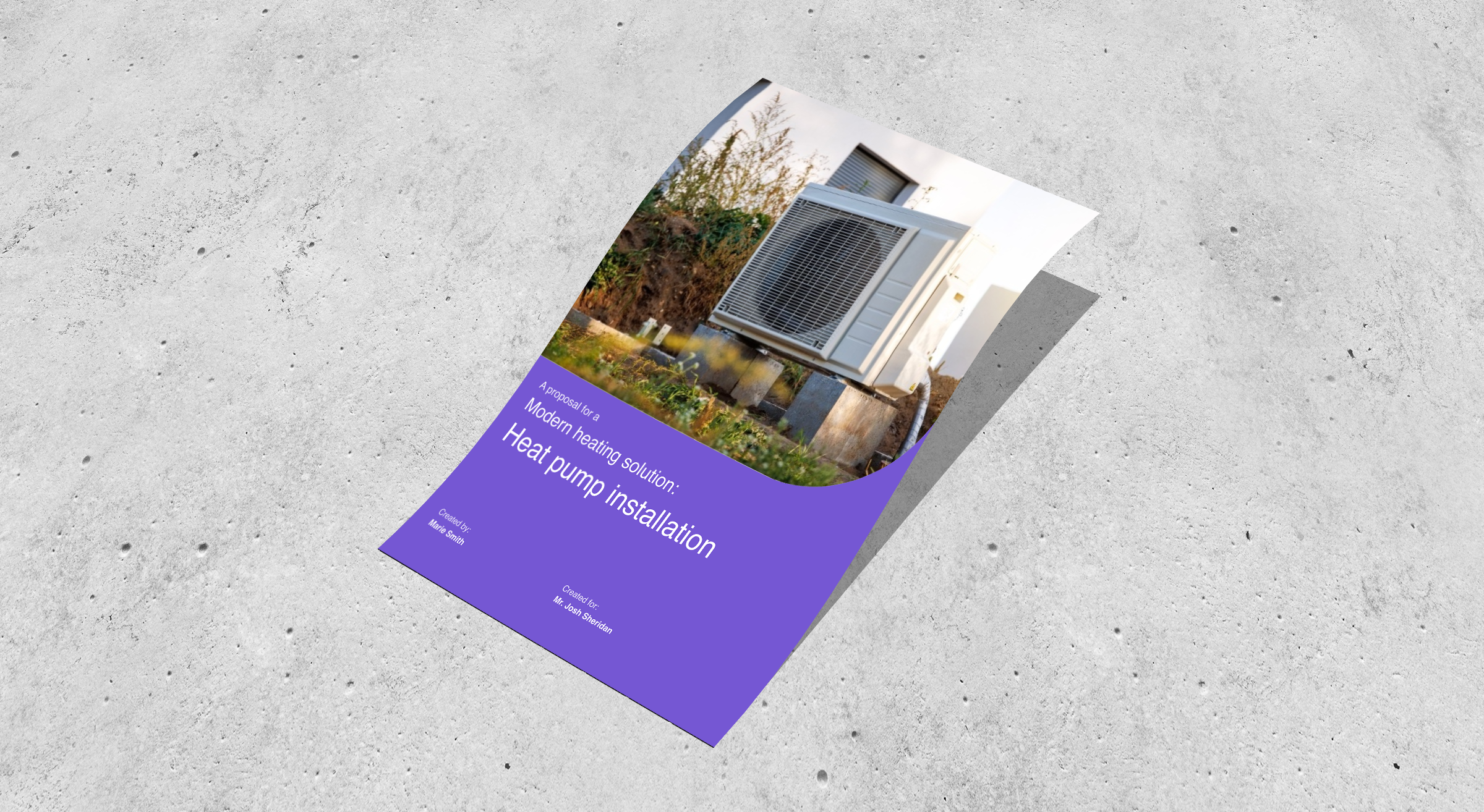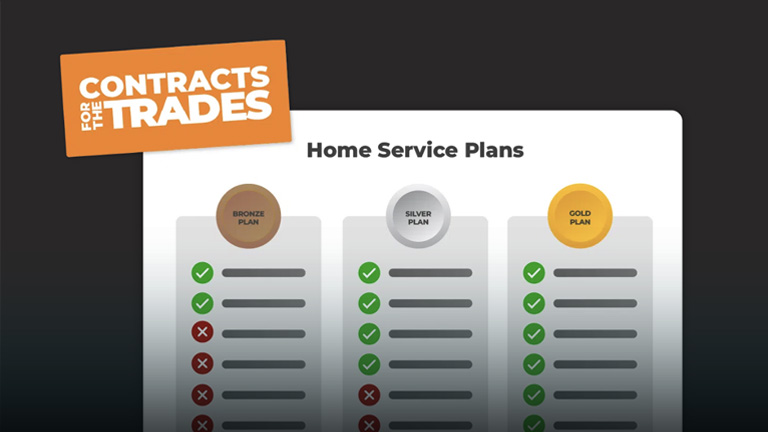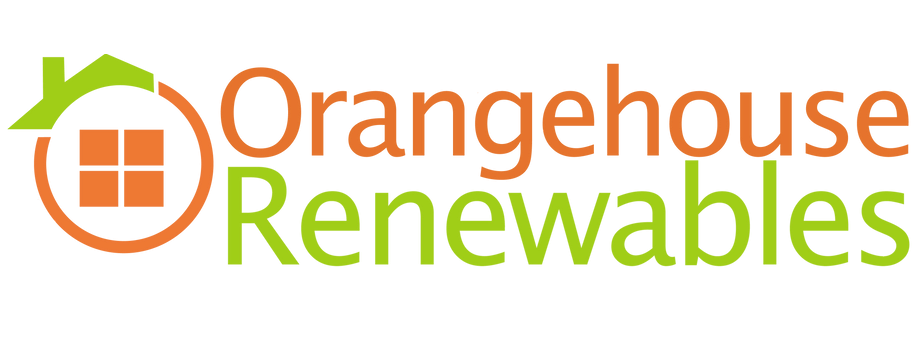What Are Service Level Agreements and How To Master Them
June 19, 2024 | Read: 9 minutes

What are service level agreements?
You probably understand the basics, but do you know how to master SLAs in order to help you win even more contracts and maximise service efficiency?
Working with multiple commercial clients at once can put stress on your business and make managing SLAs difficult, but we’ll show you how to avoid that…
If you’re equipped with the right technology, you can avoid costly fines, ensure you don’t breach SLAs and maintain great customer relationships. Altogether, it means your team can work more efficiently and maintain strong client relationships, well into the future.
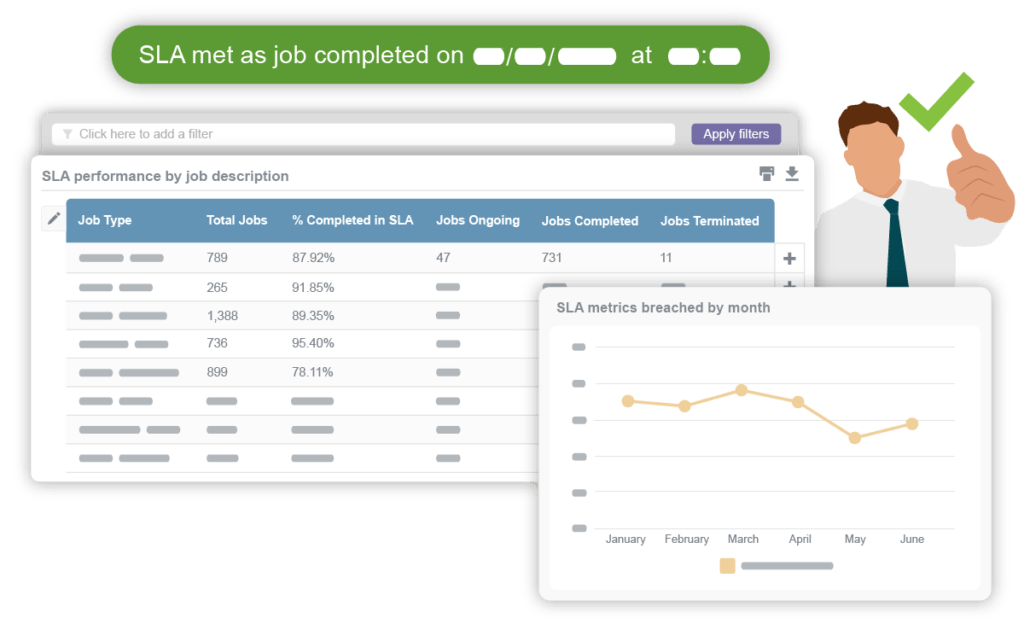
Keep reading to learn everything there is to know about the challenges of managing SLAs and the tools you need to manage them efficiently.

What is Service Level Agreement Monitoring?
Service level agreement monitoring, or SLA monitoring, is a valuable feature of field service software that helps businesses maintain and fulfil their contracted obligations to commercial or residential customers.
Each contract comes with varying levels of service that your company is able to provide but the parts of a contract related to SLA monitoring may include tasks like:

- Responding to a customer request within a specific time frame.
- For emergencies, confirming a engineer arrives on site within a certain number of hours to diagnose and solve the problem.
- Discussing and laying out the consequences your company will incur if unable to meet the agreed-upon terms.
To note: should you fail to meet the outlined service in an agreement, there may be a penalty. An example could be a £100 fine per breach, but the severity of a penalty can vary, ranging from a fine, a percentage off the price of the next service, or even your contract being terminated.
HubSpot covers more about how to create a service level agreement and establish the right terms for your business.
Why is Service Level Agreement Monitoring Important?
SLA monitoring is important for three crucial reasons, which ultimately help field service companies establish credibility and commitment to a high-quality service experience.
You’ll find that SLAs:
- Set a Standard: Having an SLA as an additional part of a contract means both parties agree there is a standard of what “quality service” means to them. This helps align your goals with your customers.
- Establish Clear Goals: The better your field service engineers are, the more you can promise clients when it comes to meeting their needs and expectations. You can use SLAs to help set goals for your staff and provide incentives for them to help improve your contracting services.
- Limit Disruption: You may have an SLA that states the downtime of an asset won’t exceed “X number of hours.” Any time lost will negatively impact your customers and your business if you aren’t properly monitoring assets and their corresponding SLAs.
Five Challenges of Service Level Agreement Monitoring
As you know, trying to maximise the number of contracts your field service engineer can handle is no walk in the park. You might encounter a handful of challenges, like those below, but fortunately, they can be solved using software:
- Tracking and Recording SLAs: The higher the volume of contracts your company manages, the harder it will become to track and record all their moving parts.
- Handling Large Data Sets: If you’re unable to make strategic decisions backed by data and statistics, you’ll have a near-impossible time figuring out the best ways to streamline your business for maximum efficiency.
- Streamlining Breach Protocols: Even if you’re not often in danger of breaching SLAs, having the most efficient protocols in place for any emergency will help you maintain that perfect SLA compliance rate.
- Maintaining Assets & Managing Downtime: It becomes extremely challenging to maintain client assets and manage downtime if you don’t have an automated system to keep track of all details listed throughout your contracts.
- Scheduling Planned Preventative Maintenance: When trying to optimise your calendar and planned preventive maintenance (PPM) you’ll be in the dark without tools like fleet management software or customer self-service portals.
Five Essential Features of SLA Monitoring Software
Now that you’ve seen some of the challenges that managing SLAs comes with, let’s look at the most useful features of monitoring software to tackle them.
1. Visual Countdowns and Timers
Service level agreements are usually based on very specific time frames. Therefore, time tracking is a critical feature of SLA monitoring software.
“How long do we have to provide the service?”, and, “What time will we breach the SLA?” are common concerns for businesses like yours.
With multiple people working on jobs, tight deadlines, and stress, it’s easy for accurate timekeeping to fall by the wayside.
Without a computer system monitoring SLA countdowns for you, there’s no dedicated point of truth. Companies like yours need a single timer that you can rely on to track how long until an SLA breaches. It’s not good enough to simply rely on people to remember.
Especially when financial penalties and your company’s reputation are on the line.
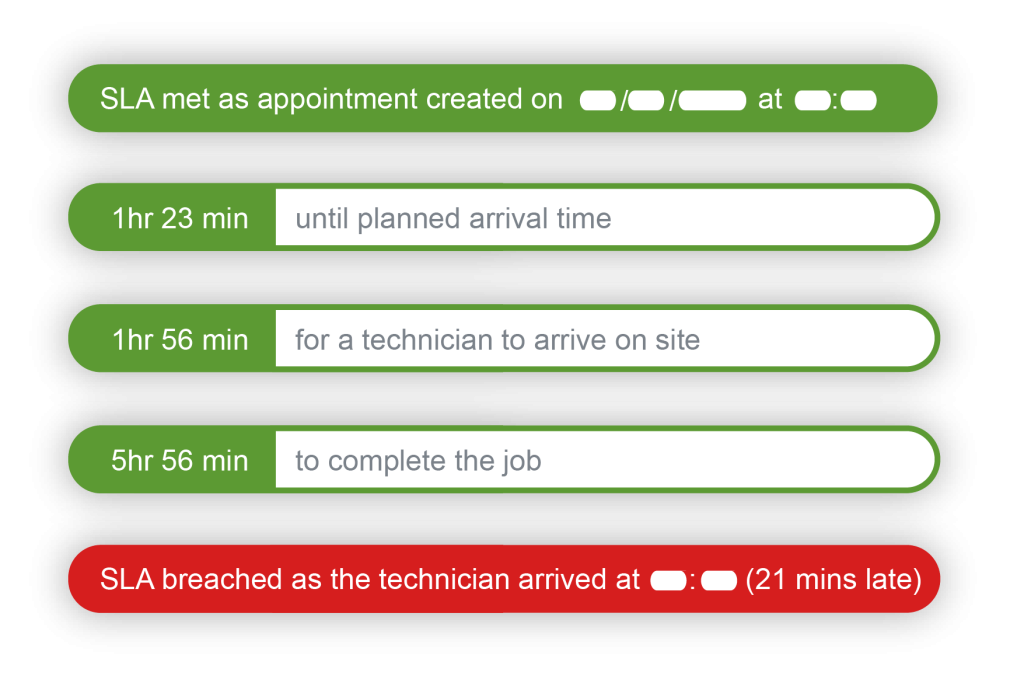
Service level agreement monitoring software can provide you with the high level of accuracy you need to track SLA countdowns. With on-screen timers, any member of the office team can quickly check how long there is left to fulfil an SLA.
If the software color-codes the timer (as it does in Commusoft’s facility management software), it can offer an easy visual to check where things stand.
2. Breach Notifications and Warnings
Countdowns and timers make it easier to stay on top of SLAs, but nothing will always be 100% perfect and breaches are inevitable over time. This can be due to traffic, a sick engineer, or other unforeseeable circumstances.
Before that happens, it’s ideal to receive a warning notification to let staff know that an SLA will soon expire.

For example: your business offers an SLA for a engineer to be on-site within four hours. Imagine three hours have passed and the SLA hasn’t been fulfilled. SLA tracking software should be able to automatically notify and warn you that there is one hour until the SLA breaches.
If the SLA does breach (i.e. the engineer arrived later than four hours), your operations director will want to be notified.
Service level agreement tracking software can provide instant notifications when an SLA is breached. So everyone is kept in the loop regarding business performance.
Similarly, you may want to send an automated email out when the SLA breaches. These can also be sent to customers, and are a good opportunity to be transparent. Use this email to acknowledge the breach and address any next steps, or follow up with any contracted requirements.
If your trades business wants to upgrade service level agreement monitoring and reporting, automatic notifications and warnings are must-haves.
3. SLA Reporting and Analytics
Instant notifications let the operations managers know when SLAs breach. But what if they want to know how many SLAs were met (or not met) in the past six months?
That’s where reporting software and analytics come in.
As you know, accurate reporting provides valuable insights into your business. For example, dedicated reporting can reveal if your team struggles with navigation. Or if there are scheduling conflicts that are affecting your team’s ability to arrive at jobs on time.
If you work for commercial clients (or would like to), they may ask for your SLA compliance, or attainment, rate. If you’re recording SLAs with a spreadsheet, attainment may be difficult to accurately track.
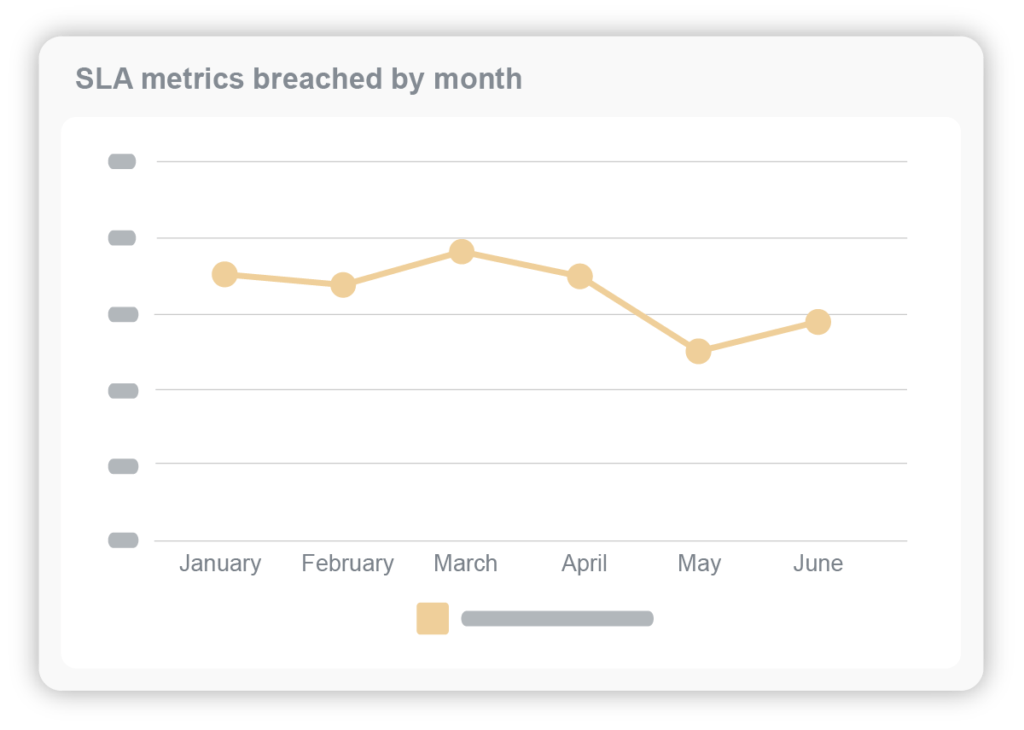
With records on every SLA, your team will always be aware of what’s going on. SLA reports allow staff to look back on breached SLAs and assess what could have been done differently to achieve a better outcome.
Knowing your SLA numbers will place you in a healthy position for future contract negotiations. Whether working with repeat, or new business, you can prove what your team is capable of achieving.
4. Segmentation and Customisation
Inflexible job management software can sometimes cause more problems than it’s worth…
When selecting software to monitor service level agreements, pick a solution that’s customisable to your needs.
Ask these questions when looking for an SLA monitoring tool:
- Is there a logical way to assign which jobs have which SLA?
- If you have a standard contract with standard SLAs, is there an easy way to create a reusable template for that?
- Can you customise how long before a breach the warning notification is sent?
Segmentation is a great example of a customisation that improves user experience. This will help you tailor service-level agreement monitoring to your business.
Not every job you do for a client will receive the same SLA. Some jobs may have no SLA at all. With segmentation, the system can automatically control which jobs are assigned to which SLAs.
By doing this, you can ensure that when a matching job is created, the SLA will be applied without the team having to manually add it themselves.
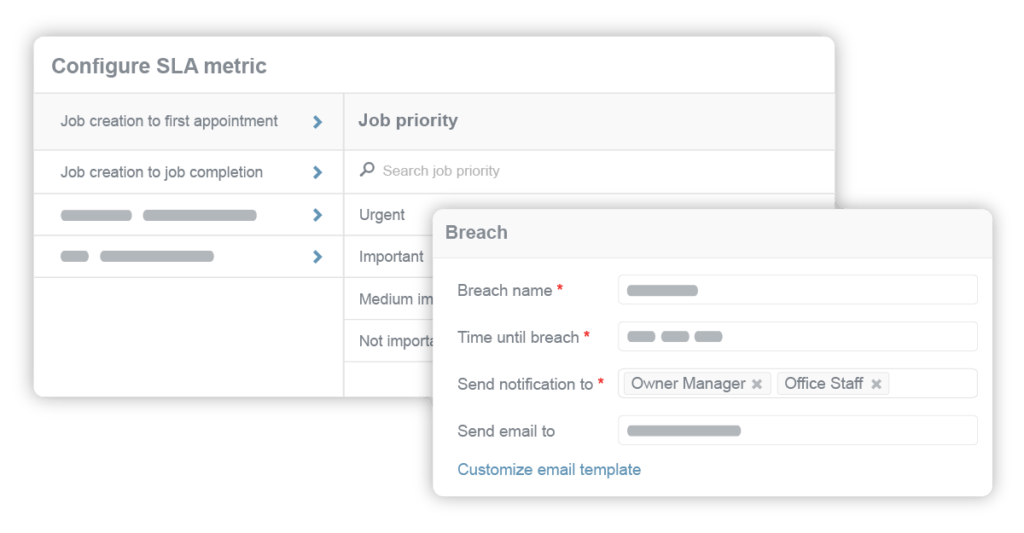
Customisations like contract templates (which can include SLAs) are more tools that can help quickly get new accounts set up with service level agreement tracking.
5. Tracking Multiple Metrics
It may seem obvious, but you need to be able to track the different types of SLAs that your business offers.
SLA monitoring software will likely have different SLA metrics hardcoded into them. And some won’t allow you to create your own. The question is, do they have the ones you need?
It needs to be able to measure the start action, the completion action, and the time between. If you offer complicated and specific SLAs, there may not be software that can properly measure them for you.
There are, however, several standard SLAs to look out for – time to schedule a job, time for an engineer on site, time for completion.
If the solution you are currently using only offers some of these metrics, it may be worth looking for a more comprehensive software, like Commusoft, for your service level agreement monitoring and reporting needs.
Automate SLA Monitoring & Exceed Customer Expectations with Commusoft
When you have service contract management software fully implemented, you’ll notice the difference immediately.
From increased team efficiency to improved client satisfaction, there’s an endless number of ways the field service management software can take your business to the next level.
Expanding your client base and maximising recurring revenue is one of the best ways to grow your business and take advantage of every opportunity that comes your way.

Emma Bozenda
When I'm not writing about the best digital solutions for field service businesses, I'm either playing with my three dogs, or baking sweet treats!

